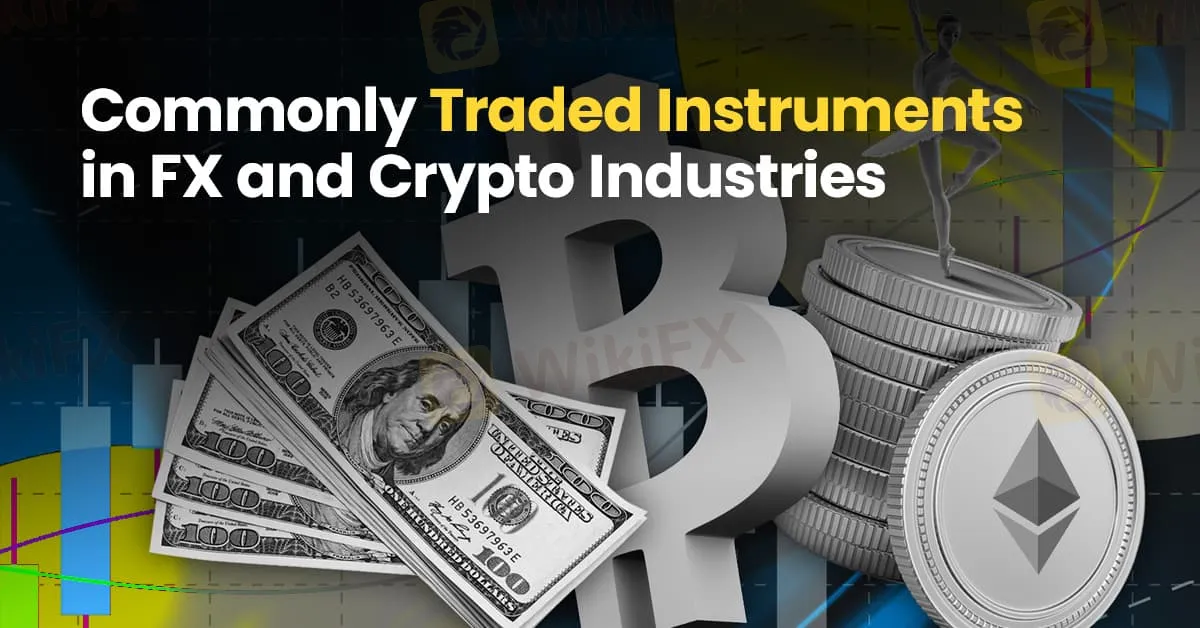简体中文
繁體中文
English
Pусский
日本語
ภาษาไทย
Tiếng Việt
Bahasa Indonesia
Español
हिन्दी
Filippiiniläinen
Français
Deutsch
Português
Türkçe
한국어
العربية
Commonly Traded Instruments in FX and Crypto Industries
Abstract:In the dynamic realm of online trading, the variety of instruments available to traders is vast. From traditional forex pairs to emerging cryptocurrencies, understanding the commonly traded instruments can enhance your trading strategy and broaden your investment horizons. Here, we delve into the most popular instruments in the forex and cryptocurrency markets, exploring their unique characteristics and the opportunities they offer.

In the dynamic realm of online trading, the variety of instruments available to traders is vast. From traditional forex pairs to emerging cryptocurrencies, understanding the commonly traded instruments can enhance your trading strategy and broaden your investment horizons. Here, we delve into the most popular instruments in the forex and cryptocurrency markets, exploring their unique characteristics and the opportunities they offer.
In the dynamic realm of online trading, the variety of instruments available to traders is vast. From traditional forex pairs to emerging cryptocurrencies, understanding the commonly traded instruments can enhance your trading strategy and broaden your investment horizons. Here, we delve into the most popular instruments in the forex and cryptocurrency markets, exploring their unique characteristics and the opportunities they offer.

Forex trading, or foreign exchange trading, is the largest financial market globally. It involves trading currency pairs, where one currency is exchanged for another. Here are the most commonly traded forex pairs:
Major Pairs:
1. EUR/USD (Euro/US Dollar): This is the most traded currency pair in the world. Its high liquidity and low volatility make it a favourite among traders.
2. USD/JPY (US Dollar/Japanese Yen): Known for its significant trading volume, this pair is influenced by economic policies and market sentiment in the US and Japan.
3. GBP/USD (British Pound/US Dollar): Often referred to as “Cable,” this pair is known for its volatility and the impact of UK economic data and Brexit developments.
4. USD/CHF (US Dollar/Swiss Franc): This pair is considered a safe haven during market turmoil due to the Swiss francs stability.
Cross Pairs:
These pairs do not include the US dollar but involve major currencies, such as:
1. EUR/GBP (Euro/British Pound): This pair reflects the economic relationship between the Eurozone and the UK.
2. EUR/JPY (Euro/Japanese Yen): This pair is popular for carry trades, where traders benefit from the interest rate differential between the two currencies.
Exotic Pairs:
Exotic pairs involve a major currency and a currency from a developing or smaller economy. Examples include:
1. USD/TRY (US Dollar/Turkish Lira): Known for its high volatility and potential for significant profit, but also higher risk.
2. EUR/PLN (Euro/Polish Zloty): This pair offers opportunities tied to the economic performance of Poland relative to the Eurozone.

Cryptocurrency trading has surged in popularity, offering a decentralized alternative to traditional currencies. Here are the most commonly traded cryptocurrencies:
Bitcoin (BTC): Bitcoin is the first and most well-known cryptocurrency. It serves as a digital gold standard in the crypto world. Due to its widespread adoption and high liquidity, BTC is a staple in many trading portfolios.
Ethereum (ETH): Ethereum is more than just a cryptocurrency; its a platform for decentralized applications (dApps). ETH's price movements are driven by its use case in smart contracts and the overall health of the blockchain ecosystem.
Ripple (XRP): Ripple focuses on enabling real-time, cross-border payments with minimal transaction fees. Its unique consensus algorithm differentiates it from other cryptocurrencies, making it attractive for institutions.
Litecoin (LTC): Often considered the silver to Bitcoin‘s gold, Litecoin offers faster transaction confirmation times. It’s popular among traders for its similarities to Bitcoin but with some technical differences that enhance its efficiency.
Binance Coin (BNB): Initially created to pay for fees on the Binance exchange, BNB has evolved to offer various use cases within the Binance ecosystem. Its growing utility has made it a prominent player in the crypto market.
Stablecoins: Stablecoins like Tether (USDT) and USD Coin (USDC) are pegged to traditional currencies (usually the US dollar) and offer stability amidst the volatility typical of the crypto market. They are used for trading and as a store of value.
While forex and cryptocurrencies are primary focuses, many traders also engage in commodities and indices:

1. Gold (XAU/USD): A traditional safe-haven asset that traders flock to during economic uncertainty.
2. Oil (WTI and Brent Crude): Prices are influenced by geopolitical events, supply and demand dynamics, and OPEC decisions.

1. S&P 500: This index represents the performance of 500 large companies listed on stock exchanges in the United States.
2. NASDAQ 100: Focuses on the 100 largest non-financial companies listed on the NASDAQ stock exchange, heavily weighted towards technology.
In conclusion, understanding the commonly traded instruments in the forex and cryptocurrency markets is crucial for any trader. Each instrument comes with its own set of characteristics, influencing factors, and risk-reward profiles. By diversifying your trading portfolio across different instruments, you can better manage risk and capitalize on a broader range of market opportunities. Whether you are trading major forex pairs, diving into the world of cryptocurrencies, or exploring commodities and indices, a well-rounded knowledge base is essential for success in the dynamic trading landscape.

Disclaimer:
The views in this article only represent the author's personal views, and do not constitute investment advice on this platform. This platform does not guarantee the accuracy, completeness and timeliness of the information in the article, and will not be liable for any loss caused by the use of or reliance on the information in the article.
Read more

Exclusive Markets Under the Scanner: Traders Report High Swap Charges, Deposit Discrepancies & More
Is your forex trading account experience at Exclusive Markets far from good? Do you witness high swap fees and daily charges? Does the deposit fail to reflect in your Exclusive Markets Login? Don’t receive adequate response from the customer support official on your trading queries? You are not alone! Traders have already alleged that the forex broker is involved in these activities. In this Exclusive Markets WikiFX review article, we shared some traders’ comments. Read on to know about them.

Is Amillex Safe or a Scam? Understanding Rules and Security
You are asking an important question: Is Amillex safe or a scam? The simple answer is that Amillex works in an unclear area that needs careful study. It is not a complete scam like fake websites that steal your money right away, but it also does not meet the safety rules of the best, well-regulated brokers. Read on to explore more details.

Saxo Bank Japan Expands European Stock Portfolio with UBS, Ferrari, and Other Major Names
Saxo Bank Japan is broadening its investment offerings by adding over 100 European stocks from Denmark, Italy, Spain, and Switzerland. The expansion—set to launch on November 5, 2025—includes globally recognized companies such as UBS, Ferrari, Novo Nordisk, and Nestlé. This initiative enhances Saxo Bank Japan’s already extensive global stock lineup, aiming to support investors seeking diversification into leading European industries.

Amillex Broker Affiliate Program: A Complete Guide to Earning with Referrals
The Amillex Broker affiliate and partnership programs offer an excellent chance for people and businesses to earn steady income by referring new traders. Simply put, this is your opportunity to make money from your network, website visitors, or social media followers by working with a trusted, high-quality broker. This partnership gives you competitive payment rates, strong benefits for partners, and reliable support to help you succeed. This complete guide covers everything you need to know, from understanding how you can earn money to following a clear plan for increasing your income. We will show you how to turn your influence into steady and growing earnings.
WikiFX Broker
Latest News
Latest FCA Daily Alerts and Consumer Warnings for 2025
Webull Widens Crypto Futures with Coinbase Derivatives
Is Nash Markets Regulated or Risk? Truth About Nash Markets’ License & Withdrawal Issues
Angel one 2025 Review & Complaints
Exclusive Markets Under the Scanner: Traders Report High Swap Charges, Deposit Discrepancies & More
Annual Sales Of New Vehicles Expected To Hit Only 15.7 Million Units: Cox
Saxo Bank Japan Expands European Stock Portfolio with UBS, Ferrari, and Other Major Names
Amillex Broker Affiliate Program: A Complete Guide to Earning with Referrals
New SC Rules Take Effect in November 2025: What’s Next for Finfluencers?
Is Amillex Safe or a Scam? Understanding Rules and Security
Currency Calculator



